Uses of aminoglycosides - Study guides, Class notes & Summaries
Looking for the best study guides, study notes and summaries about Uses of aminoglycosides? On this page you'll find 428 study documents about Uses of aminoglycosides.
Page 2 out of 428 results
Sort by

-
NR 293 Final Exam Questions With Answers Latest 2023/2024 Graded A+
- Exam (elaborations) • 51 pages • 2023
- Available in package deal
-
- $20.49
- + learn more
NR 293 Final Exam Questions With Answers Latest 2023/2024 Graded A+. signs of bleeding (liver damage) check for superinfection beta lactam penicilins MOA - answersafest class bacteriocidal inhibition of bacterial cell wall synthesis uses of penicillins - answerstrep staph pneumonia meningitis skin, bone, and joint infections stomach infections blood and valve infections gas gangrene tetanus anthrax sickle cell anemia in infants broad spectrum penicillin - answerbacteriocidal eco...
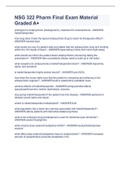
-
NSG 322 Pharm Final Exam Material Graded A+
- Exam (elaborations) • 16 pages • 2023
-
- $11.99
- 1x sold
- + learn more
prototype for antipsychotic (trade/generic), treatment for schizophrenia - ANSWER-haldol/haloperidol how long does it take the typical antipsychotic drug to reach its therapeutic effect? - ANSWER-several days what would you say if a patient calls and states that the antipsychotic drug isn't working within the 1st couple of days? - ANSWER-keep taking it (they don't work right away) what should we inform the patient about antipsychotics concerning taking the prescription? - ANSWER-take ...

-
NR 293 Final Exam 2023/2024 Latest Update Graded A+
- Exam (elaborations) • 44 pages • 2023
-
Available in package deal
-
- $16.99
- + learn more
NR 293 Final Exam 2023/2024 bacteriostatic - answerdrugs that do not kill the bacteria, but slows their growth culture and sensitivity - answertake a blood culture so we can determine where the bacteria is growing; sensitivity report determines the best treatment antibiotic combos - answerAdditive potentiative antagonisitic empiric therapy - answertreatment of an infection before specific culture information has been obtained definitive therapy - answerantibiotic therapy tailored to treat ...

-
ATI Proctored Nursing Care of Children exam study guide verified 100%
- Exam (elaborations) • 24 pages • 2024
- Available in package deal
-
- $11.99
- + learn more
ATI Proctored Nursing Care of Children exam study guide verified 100% death and dying: therapeutic communication chapter 11 - allow an opportunity for anticipatory grieving. consistency among nursing personnel. encourage parents to remain with client. communicate with the client honestly and respectfully. encourage independence. provide and clarify information and explainations. encourage physical contact: address feelings, and show concern empathy and support. health promotion of adolesc...
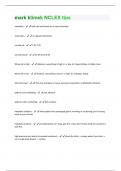
-
mark klimek NCLEX tips Questions and Answers
- Exam (elaborations) • 6 pages • 2024
- Available in package deal
-
- $8.89
- + learn more
metabolic - both pH and bicarb are in same direction respiratory - in opposite directions normal pH - 7.35-7.45 normal bicarb - 22-26 (2+2+2=6) When pH is high - Alkalosis. everything is high, K+ is low. Ex: hyperreflexia, irritable, taco, When pH is low - Acidosis. everything is low, K+ is high. Ex: lethargic, Brady Mac Kussmaul - The only acid base to cause Kussmaul respirations is Metabolic ACidosis patient over ventilating - pick alkalosis patient under ventilating - pick acidosis m...
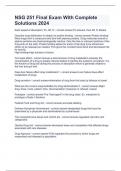
-
NSG 251 Final Exam With Complete Solutions 2024
- Exam (elaborations) • 28 pages • 2024
-
- $13.49
- + learn more
NSG 251 Final Exam With Complete Solutions 2024Rank speed of absorption: Po, IM, IV - correct answer-Po slowest, then IM, IV fastest Describe drug distribution in relation to protein binding - correct answer-Protein binding- Most drugs form a compound and bind with plasma proteins. Drug molecules bound to plasma proteins are pharmacologically inactive. Only the free or unbound portions of the drug acts on the cells. Protein binding allows for some of the drug to be stored and others to be rel...
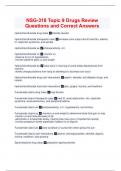
-
NSG-318 Topic 9 Drugs Review Questions and Correct Answers
- Exam (elaborations) • 6 pages • 2024
- Available in package deal
-
- $9.99
- + learn more
Hydrochlorothiazide drug class thiazide diuretic Hydrochlorothiazide therapeutic uses increase urine output and to treat htn, edema, hf, nephrotic syndrome, and ascites Hydrochlorothiazide se photosensitivity, o.h. Hydrochlorothiazide nc -monitor vs -observe for s/s of hypokalemia -monitor patient's daily uo and weight Hydrochlorothiazide pe -take early in morning to avoid sleep disturbances from nocturia -slowly change positions from lying to standing b/c dizziness can occur Hydrochloroth...

-
NURS 5334 Pharmacology Module 1 Quiz
- Exam (elaborations) • 37 pages • 2024
-
Available in package deal
-
- $12.00
- + learn more
NURS 5334 Pharmacology Module 1 Quiz MODULE 1 1. What are the BON rules and regulations for prescriptive authority for the advance practice nurse? 1. Texas is very restricted 2. Describe the pharmacokinetic processes of absorption, distribution, metabolism and elimination and how differences in these areas affect drug action. 1. Absorption 1. Drug’s movement from the site of administration into the blood. 2. Distribution 1.Drug’s movement from the blood into the interstitial space ...
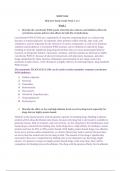
-
NRNP 6566 Midterm Study Guide 2024 with Complete Solutions.
- Exam (elaborations) • 15 pages • 2024
-
- $12.99
- + learn more
NRNP 6566 Midterm Study Guide 2024 with Complete Solutions. Week 1 1. Describe the cytochrome P450 system. Describe how inducers and inhibitors affect the cytochrome system and how that affects the half-life of medications. Cytochromes P450 (CYPs) are a superfamily of enzymes containing heme as a cofactor that function as monooxygenases. In mammals, these proteins oxidize steroids, fatty acids, and xenobiotics, and are important for the clearance of various compounds, as well as for hormon...
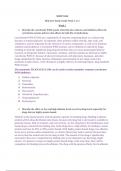
-
NRNP 6566 Midterm Study Guide 2024 with Complete Solutions.
- Exam (elaborations) • 15 pages • 2024
-
- $12.99
- + learn more
NRNP 6566 Midterm Study Guide 2024 with Complete Solutions. Week 1 1. Describe the cytochrome P450 system. Describe how inducers and inhibitors affect the cytochrome system and how that affects the half-life of medications. Cytochromes P450 (CYPs) are a superfamily of enzymes containing heme as a cofactor that function as monooxygenases. In mammals, these proteins oxidize steroids, fatty acids, and xenobiotics, and are important for the clearance of various compounds, as well as for hormon...

Did you know that on average a seller on Stuvia earns $82 per month selling study resources? Hmm, hint, hint. Discover all about earning on Stuvia


